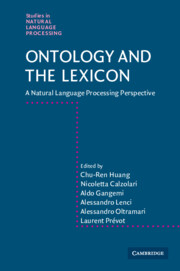Book contents
- Frontmatter
- Contents
- Contributors
- Preface
- Part I Fundamental aspects
- 1 Ontology and the lexicon: a multidisciplinary perspective
- 2 Formal ontology as interlingua: the SUMO and WordNet linking project and global WordNet
- 3 Interfacing WordNet with DOLCE: towards OntoWordNet
- 4 Reasoning over natural language text by means of FrameNet and ontologies
- 5 Synergizing ontologies and the lexicon: a roadmap
- Part II Discovery and representation of conceptual systems
- Part III Interfacing ontologies and lexical resources
- Part IV Learning and using ontological knowledge
- References
- Index
5 - Synergizing ontologies and the lexicon: a roadmap
from Part I - Fundamental aspects
Published online by Cambridge University Press: 06 July 2010
- Frontmatter
- Contents
- Contributors
- Preface
- Part I Fundamental aspects
- 1 Ontology and the lexicon: a multidisciplinary perspective
- 2 Formal ontology as interlingua: the SUMO and WordNet linking project and global WordNet
- 3 Interfacing WordNet with DOLCE: towards OntoWordNet
- 4 Reasoning over natural language text by means of FrameNet and ontologies
- 5 Synergizing ontologies and the lexicon: a roadmap
- Part II Discovery and representation of conceptual systems
- Part III Interfacing ontologies and lexical resources
- Part IV Learning and using ontological knowledge
- References
- Index
Summary
Formal mappings between ontologies
The establishment of mappings with precise semantics between formal ontologies constitutes one of the central tasks in research on ontology. This requirement affects primarily ontologies and their reciprocal understandability in shared environments like the Semantic Web, providing also a solid infrastructure for the interoperability of ontolex resources.
Suppose that a naive agent, human or artificial, wants to know the meaning of the word ‘thesaurus’. A query submitted to WordNet returns the gloss: a book containing a classified list of synonyms. Navigating through the upward hierarchy, our agent might discover that a {book} is an {artefact}, and then a {physical object}. This result is trivial, indeed. But what about the ‘content’ of the book? Does it make sense to refer to contents as mere physical objects? To us, as human beings, this is obviously not the case. However, we know this is ‘obvious’ because of our (relatively) huge background world knowledge. Is there a conceptual model that can help a naive agent (e.g. a personal software agent that needs to be trained) to shape this knowledge? SUMOwn, Cycwn and DOLCEwn (respectively, the integration of SUMO, Cyc and DOLCE with WordNet) can be exploited for this task. For example, SUMOwn represents book as a ContentBearingPhysical, namely something physical that ‘contains’ some information about a given topic; Cycwn gives a similar conceptualization by linking thesaurus to Object-type entities, those collections of things that are partially like a physical object.
- Type
- Chapter
- Information
- Ontology and the LexiconA Natural Language Processing Perspective, pp. 72 - 78Publisher: Cambridge University PressPrint publication year: 2010



